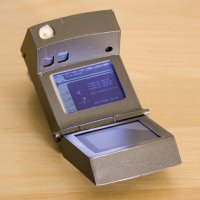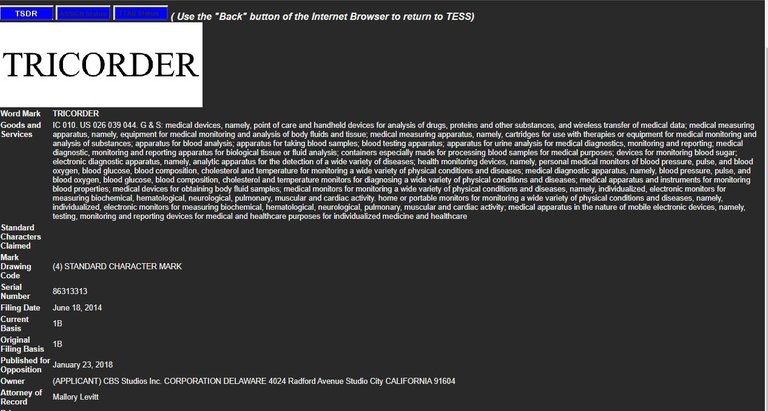Over a year ago I made a steemhunt post about the Tricorder Project. Due to the current pandemic (and recently having eye surgery) that seems to be worth revisiting.

The Word "Tricorder"
The "tri-" in tricorder represents three functions:
- sensor
- computer
- recorder
or is short for "tri-function recorder" according to Memory Alpha.
According to the Wikipedia entry for Tricorder a clause in show creator Gene Roddenberry's contract allows any company to use the word "tricorder" for functional tricorder-like technology. However, no citation for that claim is available on Wikipedia. Using the uspto.gov Trademark Electronic Search System I can find examples of abandoned and canceled use of the Tricorder trademark. As far as I can tell all current commercial use of the Tricorder mark is registered by CBS Studios Inc. and that seems to include functioning medical technology.
I can't say I am surprised. Not because a claim on Wikipedia might be false. Because of the official guidelines for fan-made Star Trek films and watching the Lore Reloaded YouTube channel.

Fictional Tricorders
The Star Trek franchise has many variations of tricorders used by Starfleet and other alien races. Generally there are tricorders for medical use, engineering or scanning the local environment. Every tricorder is handheld or portable and has multiple functions. Tricorders can detect, analyze and record data.
The Tricorder Project
The Tricorder Project (developed by Dr. Peter Jansen (PhD) is dedicated to making an accessible handheld device that can detect, analyze and display data. Looking at it I think the best analog to compare it to would be a NASA Mars rover. There are multiple sensors in the open source tricorder-like device and the design has to ensure that each sensor doesn't interfere with another one.
All of the project's tricorders are based around three categories of sensor:
- Electromagnetic
- Spatial
- Atmospheric
On the project's website are construction instructions for two generations of tricorders: Science Tricorder Mark 1 and Science Tricorder Mark 2. The "About and Story" section of the project's website also lists a Science Tricorder Mark 3 and Science Tricorder Mark 4 but there aren't any obvious links to instructions for those items. To be precise there is also a Mark 5 prototype but I'll review the first four to start.
The Science Tricorder Mark 1 is bulky compared to the Science Tricorder Mark 2. According to the hardware specifications the Science Tricorder Mark 1 is powered by six AAA rechargeable batteries while the Science Tricorder Mark 2 has a LiPo 1000 mAh battery. The Science Tricorder Mark 2 also uses higher-resolution sensors and an experimental imaging sensor. The Science Tricorder Mark 2 is also capable of running an operating system (linux). The Science Tricorder Mark 2 also has several ports available on the right-hand side for connectivity options.
Rather than 3D printing a case, polystyrene sheets were cut and layered. I suppose this is to fall within the project's goal of making the Science Tricorder economically accessible.
The small amount of information I can find about Science Tricorder Mark 3 and 4 indicates further development went toward beefing up the hardware and software capabilities while also making prototyping more affordable.
While looking around the project's blog I found a Mark 5 prototype that is an "Arducorder" or Arduino-compatible tricorder with a GitHub Repository for the prototype.
I didn't notice it before when I wrote the steemhunt post for this project but it seems like the Tricorder Project is becoming defunct. The project's blog, twitter and facebook have been relatively inactive in the last few years. All the way back in 2014 on the project's community forum a user was asking if the project was dead. Maybe the Tricorder Project just hasn't yet got a lot of community involvement. That would be a shame because this is a great educational idea that still has a lot of potential.
Conclusion
Even though the Tricorder Project is nowhere close to the type of medical tricorder seen on Star Trek it is a large step toward the Starfleet-issued engineering tricorders.
A real life medical tricorder resulted from the Qualcomm Tricorder XPRIZE a few years ago so it seems inevitable that tricorders will become routine not just in diagnosis and treatment but also preventative medicine. I can't currently scan my left eye and send daily reports to my doctor about how well my donor cornea is doing so I have to physically go in for appointments during a pandemic when I should be going out as little as possible. Maybe in a decade or two that will be possible. Just throw in a Star Trek replicator and holodeck with the tricorder and I would be set to thrive through the next pandemic.